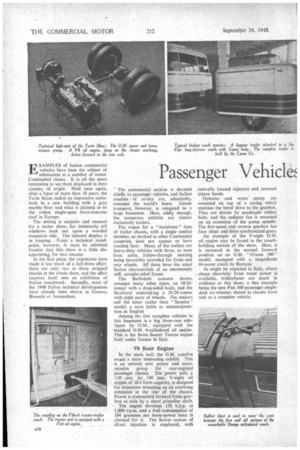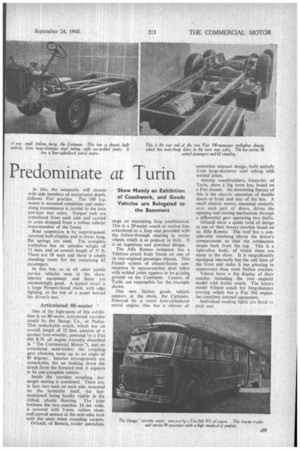Passenger Vehicle
Page 84

Page 85

If you've noticed an error in this article please click here to report it so we can fix it.
Predominate at Turin EXAMPLES of Italian commercial vehicles have been the subject of admiration at a number of recent Continental shows. It is all the more interesting to see them displayed in their country of origin. Held once again, after a lapse of more than 10 years, the Turin Salon makes an impressive comeback in a new building with a grey marble floor and what is claimed to be the widest single-span ferro-concrete roof in Europe.
The setting is majestic and unusual for a motor show, for immensely tall windows -look out upon a wooded mountain side. The internal display is in keeping. From a technical standpoint, however, it must be admitted frankly that this show is a little disappointing, for two reasons In the first place, the organizers have made it too much of a full-dress affair; there are only two or three stripped chassis in the whole show, and the affair resolves itself into an exhibition of Italian coachwork. Secondly, most of the 1948 Italian technical developments have already been shown in Geneva, Brussels or Amsterdam. The commercial section is devoted chiefly to passenger vehicles, and Italian coaches of to-day are, admittedly, amongst the world's finest. Goods transport, however, is relegated to a large basement_ Here, oddly enough, the numerous exhibits are almost exclusively trailers.
The vogue for a " backbone " type of trailer chassis, with a single central member, so marked in other Continental countries, does not appear to have reached Italy. Many of the trailers are heavy-duty vehicles with three, or even four, axles, follow-through steering being invariably provided for front and rear wheels. All these have the usual Italian characteristic of an enormously stiff, straight-sided frame.
The Barboletti concern shows, amongst many other types, an 18-24tonner with a drop-sided body, and the Straliurni undertaking a 24-28-tonner with eight pairs of wheels. rhe makers call the latter trailer their " Surplus" model, a term liable to misinterpretation. in English Among the few complete vehicles in this basement is a big three-ram sidetipper by • 0.M., equipped with the standard O.M. 4--cylindered oil engine. This is the Swiss Saurer Taurus engine built under licence in Italy.
V8 Rear Engine
In the main hall, the O.M. conc'ern stages a more Interesting exhibit. This is an entirely new power and transmission group for rear-engined passenger chassis. The, power unit, a 110 mm. by 140 mm. V-eight oil engine of 10.6 litres capacity, is designed for transverse mounting on an overhung extension at the rear of the chassis. Power is transmitted forward from gearbox to axle by a short propeller shaft. " The engine develops 130 b.h.p. at 1,800 r.p.m. and a fuel consumption of 184 grammes per horse-power hour is claimed for it. The Saurer system of direct injection is employed, with centrally located injectors and recessed piston heads.
Dynamo and water pump are mounted on top of a casing which encloses the bevel drive to the gearbox. They are driven by quadruple rubber belts, and the radiator fan is mounted on an extension of the pump spindle. The five-speed and reverse gearbox has four silent and three synchronized gears.
An example of the V-eight O.M. oil engine may be found in the coachbuilding section of the show. Here, it is mounted in the normal forward position on an G.M. " Orione 580" model, equipped with a magnificent 46-seater coach by Borzani.
As might be expected in Italy, where . cheap electricity from water power is available, trolleybuses are much in evidence at this show, a fine example being the new Fiat 100-passenger singledeck six-wheeler, shown in chassis form and as a complete vehicle.
In this, the unusually stiff chassis with side members of exceptional depth, .follows Fiat practice. The 100 h.p. motor is mounted amidships and underslung transmission is carried to the twin pot-type rear axles. Torque rods are articulated from each axle and carried to arms dropped from a rolnist tubular cross-member of the frame.
Rear suspension is by superimposed. inverted balf-elliptics and in front, long, flat springs are used. The complete trolleybus has an unladen weight of 11 tons, and an overall length of 37 ft. There are 38 seats and there is ample standing room for the remaining 62 passengers.
In this bus, as in all other public service vehicles seen at the chow, interior equipment and finish are astonishingly good. A typical detail is a large Perspex-faced clock, with edge lighting, at the top of a panel behind the driver's seat.
Articulated 88-seater "
One of the high-spots of this exhibition is an 88-seater, articulated corridor coach by the Stamp Co., of Padua. This remarkable coach, which has an overall length of 52 feet, consists of a normal four-wheeler, powered by a Fiat 666 R.N. oil engine (recently described in "The Commercial Motor "), and an articulated semi-trailer, the coupling gear allowing turns up to an angle of 80 degrees. Interior arrangements are remarkable, for on looking down the coach frcm the forward end, it appears to be one complete vehicle.
Inside the corridor coupling, passenger seating is continued. There are, in fact, two seats on each side, mounted on the turntable itself, the lastmentioned being hardly visible in the ribbed, plastic flooring. The joint between the two coaches, 14 ins wide, is covered with 5-mm. rubber sheet, and curved screeos at the seat-sides turn with the seats when rounding corners.
Orlandi, of Brescia, trailer specialists, stage an interesting Jeep combination. This is a 20-seater coach or station bus, articulated to a Jeep and provided with the follow-through steering to trailer wheels which is so popuiar in Italy. It is an ingenious and practical design.
The Alfa Romeo company has a Tubauto coach body frame on one of its rear-engined passenger chassis. This French system of chassis-frame construction in square-section steel tubes with welded joints appears to be gaining ground on the Continent. Casaro. of Turin. are responsible for the example shown.
One new Italian goods vehicle appears at the show, the Cattuneo. Powered by a small four-cylindered petrol engine, this has a chassis of
somewhat unusual design, built entirely from large-diameter steel tubing with welded joints. Among coachbuilders, Garavini, of Turin, show a big town bus, based on a Fiat chassis. An interesting feature of this is the electric operation of double doors at front and rear of the bus. A small electric motor, mounted centrally over each pair of doors, drives the opening and closing mechanism through a differential gear operating two shafts.
Orlandi show a queer twist of design in one of their luxury coaches based on an Alfa Romeo. The roof has a considerable overhang above the driver's compartment so that the windscreen slopes back from the top. This is a light-alloy body, of which there are may at the show. It is magnificently equipped internally but the odd lines of the front end make it less pleasing in appearance than most Italian coaches.
Viberti have a big display of their coaches including the rear engined model with trailer coach. The luxury model Viberti coach for long-distance touring, which has a Fiat 366 engine, has excellent internal equipment.
Individual reading lights are fitted to each seat.






















































































































